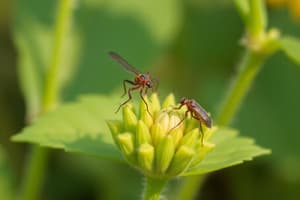Podcast
Questions and Answers
Which pests can be trapped by the yellow card?
Which pests can be trapped by the yellow card?
- Fungus gnats
- Aphids
- Whitefly (correct)
- Thrips
What is the first control method recommended in IPM programs?
What is the first control method recommended in IPM programs?
- Biological control
- Scouting
- Non-chemical control (correct)
- Chemical control
When should treatment be applied for pest control?
When should treatment be applied for pest control?
- When only a small area is affected (correct)
- When all plants are affected
- When a large area is affected
- When the season is over
What techniques are employed in IPM programs?
What techniques are employed in IPM programs?
What is the purpose of IPM programs?
What is the purpose of IPM programs?
Which type of chemicals should be used first in IPM programs?
Which type of chemicals should be used first in IPM programs?
What can spray oils help eliminate if used early in the season?
What can spray oils help eliminate if used early in the season?
Which pests are more difficult to control with IPM compared to insects?
Which pests are more difficult to control with IPM compared to insects?
What can greatly reduce the need for regular preventive sprays for plant diseases?
What can greatly reduce the need for regular preventive sprays for plant diseases?
How much fewer pesticides were used by nurseries employing the IPM program in Maryland?
How much fewer pesticides were used by nurseries employing the IPM program in Maryland?
Flashcards are hidden until you start studying
Study Notes
Integrated Pest Management (IPM) Programs
- The yellow card can trap aphids, whiteflies, and other pests.
Control Methods
- In IPM programs, the first control method recommended is cultural practices.
Treatment Timing
- Treatment for pest control should be applied when the pest population reaches the economic injury level (EIL).
IPM Techniques
- Techniques employed in IPM programs include cultural practices, biological control, chemical control, and resistant varieties.
Purpose of IPM Programs
- The purpose of IPM programs is to reduce pesticide use and minimize harm to the environment, humans, and beneficial organisms.
Chemical Use
- In IPM programs, selective and narrow-spectrum chemicals should be used first.
Spray Oils
- Spray oils can help eliminate aphids, whiteflies, and other pests if used early in the season.
Challenging Pests
- Weeds are more difficult to control with IPM compared to insects.
Disease Prevention
- Resistant varieties can greatly reduce the need for regular preventive sprays for plant diseases.
IPM Success
- Nurseries employing the IPM program in Maryland used 70% fewer pesticides.
Studying That Suits You
Use AI to generate personalized quizzes and flashcards to suit your learning preferences.




